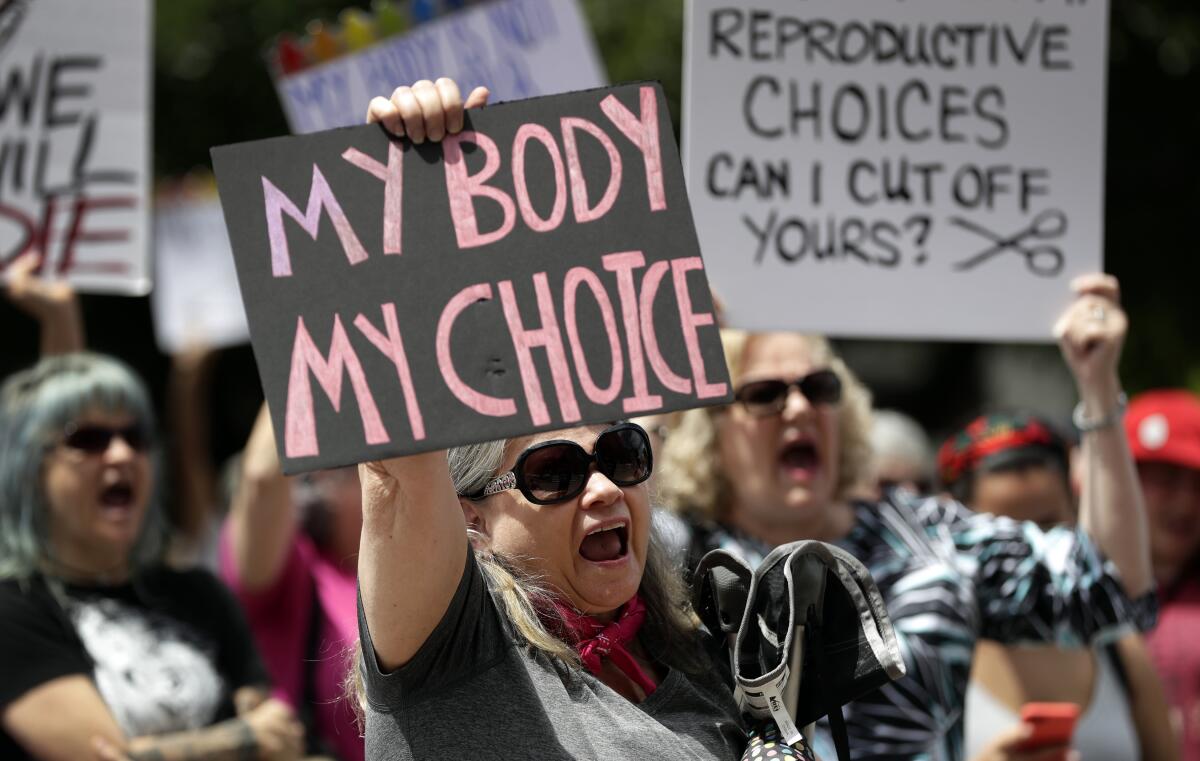Column: With Texas abortion law, a far-fetched dystopia has come to pass

- Share via
On this, Donald Trump didn’t lie.
As a presidential candidate in 2016, he said he’d name as many as three antiabortion justices to the Supreme Court, tipping its fragile balance for upholding Roe vs. Wade to favor overturning it. “That’s what will happen,” he promised.
For the record:
1:19 p.m. Sept. 3, 2021An earlier version of this article incorrectly stated that Gov. Ronald Reagan signed a bill broadly legalizing abortion in California in 1966. He signed the bill in 1967.
It effectively happened Wednesday in Texas, the nation’s second-most-populous state, where nearly 30 million residents include about 7 million women of reproductive age. The Supreme Court allowed a new law to take effect, more dystopian than anything I thought I’d ever see: Citizens are now deputized by the state, and enticed by the prospect of a $10,000 cash bounty and court costs, to sue anyone who even unknowingly helps a woman get an abortion if she’s more than six weeks pregnant. That would include not only doctors but also husbands, friends, even taxi drivers.
Texans have lost a constitutionally guaranteed right unless they act at a time in the pregnancy when most women — including me, twice — don’t even yet know they’re pregnant. This right is about more than a medical procedure. Losing the option will change the trajectory of women’s lives.
This threat to individual liberties — for Texas women as well as those in contact with them — comes thanks to Republican politicians from Gov. Greg Abbott on down who purport to prize freedom so much that they oppose mask mandates during a deadly pandemic.
It’s not like Texans overwhelmingly oppose abortion rights; in a poll in February, before the law was enacted, a majority said state restrictions should be “less strict” or “left as is.”
The statute, suddenly of interest to Republicans in other red states, is the most restrictive abortion law in the half-century since Roe. It’s also plainly unconstitutional, as dissenting justices noted. That a conservative majority of the court has treated the law as possibly otherwise is more evidence that Trump’s judicial picks will be the one-term president’s most significant legacy, long outlasting him given their life tenure.
Large, mostly rural swaths of the South and the Plains states already are virtual no-abortion zones given state restrictions on clinics that perform the procedure. Now add to that an entire sprawling state, with 254 counties, some of the biggest cities, greatest concentrations of poverty, vastest distances and least accessible healthcare.
Doctors at the four Texas clinics of Whole Woman’s Health worked up to midnight Tuesday to provide abortions for patients who filled waiting rooms for hours. They stopped Wednesday to avoid the new risk of civil lawsuits and forced closures. Vanessa Rodriguez, a senior manager for Planned Parenthood of Texas told reporters: “We’re getting patients who are scared, confused, angry. They’re asking questions about, ‘Is abortion still legal?’ ‘Can I still get an abortion? Am I too far along?’” The antiabortion group Texas Right to Life had a website for anonymous tips about suddenly illegal abortions.
According to Texas abortion providers, in their unsuccessful emergency petition to the Supreme Court, the law “would immediately and catastrophically reduce abortion access in Texas, barring care for at least 85% of Texas abortion patients (those who are six weeks pregnant or greater) and likely forcing many abortion clinics ultimately to close.” Women with means could go out of state for abortions, they noted, but others would have to remain pregnant or “attempt to end their pregnancies without medical supervision.”
The clock has turned back to 1972. In that year before Roe, so many Texans flew to California for an abortion (Gov. Ronald Reagan signed the law legalizing the procedure in 1967) that Planned Parenthood South Texas arranged a group airfare for 10 or more patients flying on the same day, according to an employee who searched the group’s archives. A hospital in Los Angeles — she told me she didn’t know which one — discounted the cost of performing abortions for each group of 11 patients.
However the Texas drama plays out, it seems clear that abortion rights more broadly are in jeopardy.
In its term starting next month, the Supreme Court will consider a Mississippi law banning abortion after 15 weeks’ gestation. That the court even agreed in May to take the case showed the impact of the Trump justices. It’s safe to say no prior configuration of the court would have done so. Roe established a constitutional right to abortion until a fetus becomes viable, generally considered at about the 24th week of pregnancy, far beyond the cutoff dates in the Mississippi or Texas laws. As recently as 2016, the court struck down a less restrictive Texas law.
The current stampede started in 2019, just after the Senate confirmed Justice Brett Kavanaugh, the second of Trump’s nominees and the one who solidified an antiabortion majority on the high court. Red states rushed to enact clearly unconstitutional laws, to force the issue. “What I’m trying to do here is get this case in front of the Supreme Court so Roe v. Wade can be overturned,” boasted the sponsor of an Alabama law to criminalize abortion.
For decades, the antiabortion cause has spurred conservatives to political activism, in turn prompting Republican officeholders to work harder than Democrats (and play dirtier) in legislative and judicial battles. Geoff Garin, a longtime Democratic pollster, said the latest developments “will raise the stakes” in next year’s elections “and drive up Democratic turnout.”
For abortion rights, it’s most likely too late.
Three years ago this month, at Kavanaugh’s confirmation hearing, I thought the red-robed protesters evoking “The Handmaid’s Tale” were a bit over the top. I was wrong. They warned us.
More to Read
A cure for the common opinion
Get thought-provoking perspectives with our weekly newsletter.
You may occasionally receive promotional content from the Los Angeles Times.











